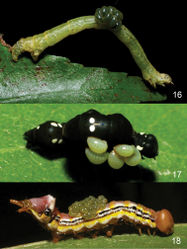Euplectrus johnnoyesi
| Notice: | This page is derived from the original publication listed below, whose author(s) should always be credited. Further contributors may edit and improve the content of this page and, consequently, need to be credited as well (see page history). Any assessment of factual correctness requires a careful review of the original article as well as of subsequent contributions.
If you are uncertain whether your planned contribution is correct or not, we suggest that you use the associated discussion page instead of editing the page directly. This page should be cited as follows (rationale):
Citation formats to copy and paste
BibTeX: @article{Hansson2015ZooKeys, RIS/ Endnote: TY - JOUR Wikipedia/ Citizendium: <ref name="Hansson2015ZooKeys">{{Citation See also the citation download page at the journal. |
Ordo: Hymenoptera
Familia: Eulophidae
Genus: Euplectrus
Name
Euplectrus johnnoyesi Hansson sp. n. – Wikispecies link – ZooBank link – Pensoft Profile
Material
Holotype a female labeled “COSTA RICA: Alajuela, ACG, Sector Pitilla, Pasmompa, 1.xi.2007, P. Rios, ex Gonodonta sinaldus eating Cissampelos pareira, sibling of wasp DHJPAR0028699, 07-SRNP-33766” (BMNH). PARATYPES: 16♀ 10♂: COSTA RICA (ACG): Alajuela: Sector Pitilla, Pasmompa: 3♀ 1♂ with same label data as holotype (BMNH, INBio); 17.x.2006, P. Rios, ex Oraesia serpens eating Cissampelos pareira, sibling of wasp DHJPAR0028863, 06-SRNP-34907 (2♀ 1♂, in INBio); 18.x.2007, M. Rios, ex Gonodonta sinaldus eating Cissampelos pareira, sibling of wasp DHJPAR0028952, 07-SRNP-33589 (1♀ 1♂, in CNC); 11.vii.2008, M. Rios, ex Gonodonta holosericea eating Cissampelos pareira, sibling of wasp DHJPAR0031154, 08-SRNP-31542 (1♀, in INBio); Sector Pitilla, Coneja: 17.vii.2005, C. Moraga, ex Gonodonta sicheas eating Cissampelos pareira, sibling of wasp DHJPAR0028807, 05-SRNP-32687 (3♀ 1♂, in BMNH); 6.xi.2005, P. Rios, ex Gonodonta holosericea eating Cissampelos pareira, sibling of wasp DHJPAR0028834, 05-SRNP-34610 (1♀ 1♂, in MIUCR); 6.xi.2005, P. Rios, ex Gonodonta holosericea on Cissampelos pareira, sibling of wasp DHJPAR0028823, 05-SRNP-34616 (3♂, in BMNH, INBio); 11.x.2007, M. Rios, ex Gonodonta sinaldus eating Cissampelos pareira, sibling of wasp DHJPAR0028954, 07-SRNP-33516 (1♀ 1♂, in USNM); 1.xi.2006, M. Rios, ex Oraesia serpens on Cissampelos tropaeolifolia, sibling of wasp DHJPAR0028858, 06-SRNP-65085 (4♀ 1♂, in BMNH, INBio).
Diagnosis
Lower face entirely yellowish-brown (female, Fig. 394) or white (male, Fig. 395), pale part not reaching hypostomal carina and with area close to mouth cavity dark (Fig. 581); fore coxa yellowish-white, remaining fore leg and mid and hind legs yellowish-brown (Fig. 393); petiole 1.0× as long as wide; gaster dark brown, anterior ½ yellowish-white (female, Fig. 396) or white (male, Fig. 397) with dark brown lateral margins; male antenna with scape slightly expanded and widest in the middle, 2.6× as long as wide (Fig. 399), flagellomeres 2–5 with a basal whorl of erect setae.
Description
Female. Length of body 2.3 mm. Antenna with scape yellowish-white, pedicel yellowish-brown, flagellomere 1 yellowish-brown, 2 pale brown, 3–6 dark brown (Fig. 398). Mandibles and palpi yellowish-white. Head black and shiny, entire lower face yellowish-brown with median part darker (Fig. 394). Frons close to eyes with two rows of setae (Fig. 404). Vertex smooth (Fig. 405). Occipital margin rounded (Fig. 405).
Mesosoma black and shiny (Fig. 393). Each sidelobe of mesoscutum with 20 setae. Scutellum 0.9× as long as wide; with very weak engraved reticulation (Fig. 406). Dorsellum along anterior margin with a very narrow groove (Fig. 767), medially 0.1× as long as length of dorsellum. Propodeum with very weak reticulation (Fig. 767); anteromedially with a semicircular cup that has posterior part strongly raised and is distinctly higher than anterior part; propodeal callus with eight setae. Legs (Fig. 393): fore coxa yellowish-white, remaining fore leg and mid and hind legs yellowish-brown. Fore wing: costal cell on ventral surface with two rows of setae in basal ⅔ and one row in apical ⅓, and margin with six setae close to marginal vein; with 16 admarginal setae, in one row.
Gaster dark brown, anterior ½ yellowish-white with dark brown lateral margins (Fig. 396).
Ratios. HE/MS/WM = 2.1/1.0/1.4; POL/OOL/POO = 4.9/2.9/1.0; OOL/DO = 1.4; WE/WF/WH/HH = 1.0/2.5/4.5/3.2; WH/WT = 1.1; PM/ST = 1.6; TS1/TS2/LT/LT1/LT2/LT3/LT4 = 4.0/2.4/6.4/2.0/1.4/1.0/1.8; LP/WP = 1.0; MM/LG = 0.9.
Male. Length of body 1.8 mm. Scape slightly expanded and widest in the middle (Fig. 399), sensory pores confined to apicoventral ¾, sensory area pale as scape. Otherwise similar to female except flagellomeres 2–5 with a basal whorl of erect setae (Fig. 399); entire lower face white (Fig. 395); scutellum with posterior ¼ smooth; gaster shorter and with pale part white.
Ratios. LC/WS = 2.6; MM/LG = 1.2.
Hosts and biology
Feeding on various instars of Gonodonta holosericea, Gonodonta sicheas, Gonodonta sinaldus, Oraesia serpens (all are Erebidae), feeding on Cissampelos pareira and Cissampelos tropaeolifolia (Menispermaceae), parasitoid cocoons stuck to dead larva and substrate.
Distribution
Costa Rica (Alajuela Province).
Etymology
This species is named after John S. Noyes, in recognition of his contribution to the understanding of ACG Hymenoptera taxonomy.
Remarks
Euplectrus johnnoyesi is morphologically identical to Euplectrus sydneycameronae, but differs in the barcode and biology. See remarks under Euplectrus sydneycameronae.
Original Description
- Hansson, C; Smith, M; Janzen, D; Hallwachs, W; 2015: Integrative taxonomy of New World Euplectrus Westwood (Hymenoptera, Eulophidae), with focus on 55 new species from Area de Conservación Guanacaste, northwestern Costa Rica ZooKeys, (485): 1-236. doi
Images
|




